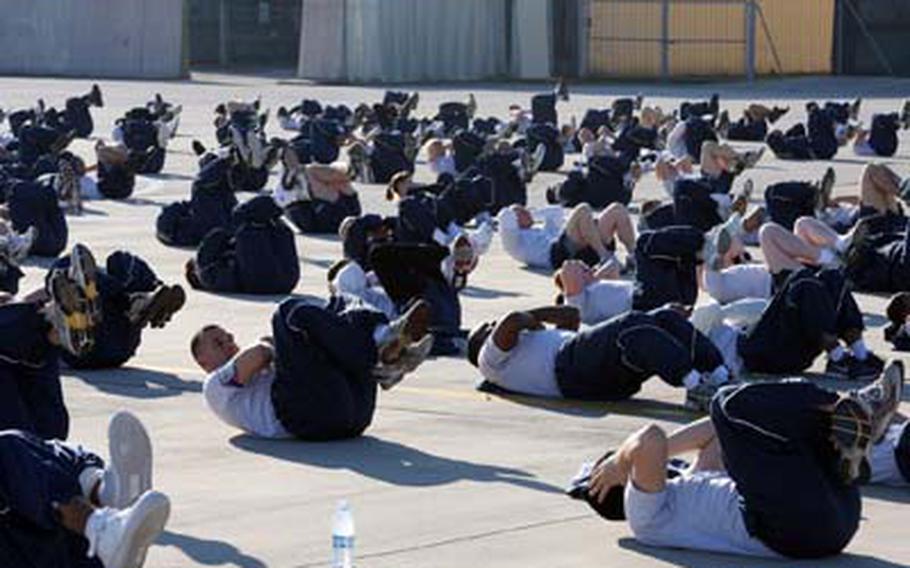
Members of the 31st Aircraft Maintenance Squadron do sit-ups as part of Air Force Wingmen Day at Aviano Air Base, Italy. (Christopher Sawaryn/Courtesy of U.S. Air Force)
No changes are planned yet for fitness programs at U.S. Air Force bases in Europe on the heels of a worldwide Air Force audit that found that unit-based fitness policies tend to promote a "fit to test" instead of a "fit to fight" culture.
U.S. Air Forces in Europe officials, however, said Tuesday that the audit identifies several recommendations for Air Force-wide policy change and that they would work to implement those revisions once new Air Force policy is established.
"In the meantime, we’ll continue to stress the importance of good, year-round fitness habits coupled with timely and accurate fitness testing," USAFE officials said in a written response to Stars and Stripes.
The report — released by the Air Force Audit Agency in early December — found that unit commanders were not properly managing fitness programs and unit-based fitness programs did not effectively promote a healthy lifestyle.
"Unit based fitness policies did not include adequate management controls, such as conducting unannounced random body composition assessments and related intervention actions, to hold members individually accountable for year-round physical fitness," the report states. Holding annual assessments at predetermined intervals allows airmen "to prepare just before the test, thereby promoting a ‘fit to test’ culture."
Of 321 airmen reviewed, 35 gained an average of 3 inches in abdominal circumference and nine pounds within 60 days after taking the annual fitness test, the audit states.
An airman at Royal Air Force Lakenheath, United Kingdom, for example, gained seven pounds and 3.5 inches in waist circumference, and an airman at Kadena Air Base, Okinawa, Japan, gained seven pounds and 3 inches just two months after a December assessment, according to the report.
Thirteen locations from eight major commands were included in the audit. Lakenheath was the only USAFE base reviewed.
The evaluation also determined, among other findings, that unit commanders did not consistently allow airmen time for physical activity during duty hours, whether through group exercise or individual workouts.
Air Force policy directs unit commanders to issue written policy detailing a unit-based fitness program providing three sessions of group exercise and allowing airmen 90 minutes of duty time a week for individual fitness activity.
But for some airmen, especially aircraft maintainers pulling 12-hour shifts on a busy flight line, mission often gets in the way, according to Tech. Sgt. Edward Pfeifer, a unit security manager with the 86th Aircraft Maintenance Squadron at Ramstein Air Base, Germany.
Pfeifer’s unit meets several times a week for group circuit training, calisthenics or running. But typical attendance ranges from five to 20 – from a squadron with close to 300 airmen, Pfeifer said.
The only airmen held to working out up to 90 minutes weekly are those who fail a fitness test, he said.
"We need to get PT (physical training) into the work schedule," he said, "which is about impossible when we’re on 12-hour shifts and we don’t have the manning for it."
"The Air Force," he added, "is going in the right direction pushing PT," but it will be difficult for some career fields to find that delicate balance between mission and fitness. "One’s going to have to suffer."
The audit laid out several recommendations, including having unannounced random body-composition assessments year-round and intervention measures for those below standard.
Air Force officials at the Pentagon did not get back to Stripes by deadline on what Air Force-wide changes might be made to the Air Force fitness program as a result of the audit.
One major command has already shaken up its fitness program. Following the release of the audit, U.S. Pacific Forces Commander Gen. Howie Chandler ordered major changes be made to the fitness program at all PACAF bases, including having Health and Wellness Center staff members take charge of annual testing, follow-up, remedial training, and healthy-living programs. Two PACAF bases were part of the fitness review.